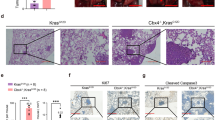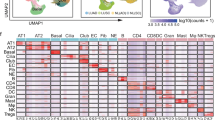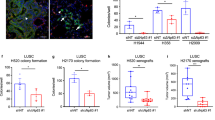Abstract
Lung cancer is a leading cause of cancer death, where the amplification of oncogenes contributes to tumorigenesis. Genomic profiling of 128 lung cancer cell lines and tumors revealed frequent focal DNA amplification at cytoband 14q13.3, a locus not amplified in other tumor types. The smallest region of recurrent amplification spanned the homeobox transcription factor TITF1 (thyroid transcription factor 1; also called NKX2-1), previously linked to normal lung development and function. When amplified, TITF1 exhibited increased expression at both the RNA and protein levels. Small interfering RNA (siRNA)-mediated knockdown of TITF1 in lung cancer cell lines with amplification led to reduced cell proliferation, manifested by both decreased cell-cycle progression and increased apoptosis. Our findings indicate that TITF1 amplification and overexpression contribute to lung cancer cell proliferation rates and survival and implicate TITF1 as a lineage-specific oncogene in lung cancer.
This is a preview of subscription content, access via your institution
Access options
Subscribe to this journal
Receive 50 print issues and online access
$259.00 per year
only $5.18 per issue
Buy this article
- Purchase on SpringerLink
- Instant access to full article PDF
Prices may be subject to local taxes which are calculated during checkout



Similar content being viewed by others
References
Bashyam MD, Bair R, Kim YH, Wang P, Hernandez-Boussard T, Karikari CA et al. (2005). Array-based comparative genomic hybridization identifies localized DNA amplifications and homozygous deletions in pancreatic cancer. Neoplasia 7: 556–562.
Bergamaschi A, Kim YH, Wang P, Sorlie T, Hernandez-Boussard T, Lonning PE et al. (2006). Distinct patterns of DNA copy number alteration are associated with different clinicopathological features and gene-expression subtypes of breast cancer. Genes Chromosomes Cancer 45: 1033–1040.
Birmingham A, Anderson EM, Reynolds A, Ilsley-Tyree D, Leake D, Fedorov Y et al. (2006). 3′ UTR seed matches, but not overall identity, are associated with RNAi off-targets. Nat Methods 3: 199–204.
Bohinski RJ, Di Lauro R, Whitsett JA . (1994). The lung-specific surfactant protein B gene promoter is a target for thyroid transcription factor 1 and hepatocyte nuclear factor 3, indicating common factors for organ-specific gene expression along the foregut axis. Mol Cell Biol 14: 5671–5681.
Garraway LA, Sellers WR . (2006). Lineage dependency and lineage-survival oncogenes in human cancer. Nat Rev Cancer 6: 593–602.
Garraway LA, Widlund HR, Rubin MA, Getz G, Berger AJ, Ramaswamy S et al. (2005). Integrative genomic analyses identify MITF as a lineage survival oncogene amplified in malignant melanoma. Nature 436: 117–122.
Holst F, Stahl PR, Ruiz C, Hellwinkel O, Jehan Z, Wendland M et al. (2007). Estrogen receptor alpha (ESR1) gene amplification is frequent in breast cancer. Nat Genet 39: 655–660.
Jackson AL, Burchard J, Leake D, Reynolds A, Schelter J, Guo J et al. (2006). Position-specific chemical modification of siRNAs reduces ‘off-target’ transcript silencing. RNA 12: 1197–1205.
Jemal A, Siegel R, Ward E, Murray T, Xu J, Thun MJ . (2007). Cancer statistics, 2007. CA Cancer J Clin 57: 43–66.
Kao J, Pollack JR . (2006). RNA interference-based functional dissection of the 17q12 amplicon in breast cancer reveals contribution of coamplified genes. Genes Chromosomes Cancer 45: 761–769.
Kendall J, Liu Q, Bakleh A, Krasnitz A, Nguyen KC, Lakshmi B et al. (2007). Oncogenic cooperation and coamplification of developmental transcription factor genes in lung cancer. Proc Natl Acad Sci USA 104: 16663–16668.
Kent WJ, Sugnet CW, Furey TS, Roskin KM, Pringle TH, Zahler AM et al. (2002). The human genome browser at UCSC. Genome Res 12: 996–1006.
Kimura S, Hara Y, Pineau T, Fernandez-Salguero P, Fox CH, Ward JM et al. (1996). The T/ebp null mouse: thyroid-specific enhancer-binding protein is essential for the organogenesis of the thyroid, lung, ventral forebrain, and pituitary. Genes Dev 10: 60–69.
Lapointe J, Li C, Giacomini CP, Salari K, Huang S, Wang P et al. (2007). Genomic profiling reveals alternative genetic pathways of prostate tumorigenesis. Cancer Res 67: 8504–8510.
Lapointe J, Li C, Higgins JP, van de Rijn M, Bair E, Montgomery K et al. (2004). Gene expression profiling identifies clinically relevant subtypes of prostate cancer. Proc Natl Acad Sci USA 101: 811–816.
Lechner JF, Fugaro JM, Wong Y, Pass HI, Harris CC, Belinsky SA . (2001). Perspective: cell differentiation theory may advance early detection of and therapy for lung cancer. Radiat Res 155: 235–238.
Miccadei S, De Leo R, Zammarchi E, Natali PG, Civitareale D . (2002). The synergistic activity of thyroid transcription factor 1 and Pax 8 relies on the promoter/enhancer interplay. Mol Endocrinol 16: 837–846.
Minoo P, Su G, Drum H, Bringas P, Kimura S . (1999). Defects in tracheoesophageal and lung morphogenesis in Nkx2.1(−/−) mouse embryos. Dev Biol 209: 60–71.
Pollack JR, Perou CM, Alizadeh AA, Eisen MB, Pergamenschikov A, Williams CF et al. (1999). Genome-wide analysis of DNA copy-number changes using cDNA microarrays. Nat Genet 23: 41–46.
Pollack JR, Sorlie T, Perou CM, Rees CA, Jeffrey SS, Lonning PE et al. (2002). Microarray analysis reveals a major direct role of DNA copy number alteration in the transcriptional program of human breast tumors. Proc Natl Acad Sci USA 99: 12963–12968.
Puglisi F, Barbone F, Damante G, Bruckbauer M, Di Lauro V, Beltrami CA et al. (1999). Prognostic value of thyroid transcription factor-1 in primary, resected, non-small cell lung carcinoma. Mod Pathol 12: 318–324.
Ramirez RD, Sheridan S, Girard L, Sato M, Kim Y, Pollack J et al. (2004). Immortalization of human bronchial epithelial cells in the absence of viral oncoproteins. Cancer Res 64: 9027–9034.
Sato M, Shames DS, Gazdar AF, Minna JD . (2007). A translational view of the molecular pathogenesis of lung cancer. J Thorac Oncol 2: 327–343.
Tan D, Li Q, Deeb G, Ramnath N, Slocum HK, Brooks J et al. (2003). Thyroid transcription factor-1 expression prevalence and its clinical implications in non-small cell lung cancer: a high-throughput tissue microarray and immunohistochemistry study. Hum Pathol 34: 597–604.
Tanaka H, Yanagisawa K, Shinjo K, Taguchi A, Maeno K, Tomida S et al. (2007). Lineage-specific dependency of lung adenocarcinomas on the lung development regulator TTF-1. Cancer Res 67: 6007–6011.
Tian J, Mahmood R, Hnasko R, Locker J . (2006). Loss of Nkx2.8 deregulates progenitor cells in the large airways and leads to dysplasia. Cancer Res 66: 10399–10407.
Tibshirani R, Wang P . (2008). Spatial smoothing and hot spot detection for CGH data using the fused lasso. Biostatistics 9: 18–29.
Travis WD, Brambilla E, Muller-Hermelink HK, Harris CC . (2004). Pathology & Genetics: Tumours of the lung, pleura, thymus and heart. (World Health Organization Classification of Tumours). IARC Press: Lyon.
Visakorpi T, Hyytinen E, Koivisto P, Tanner M, Keinanen R, Palmberg C et al. (1995). In vivo amplification of the androgen receptor gene and progression of human prostate cancer. Nat Genet 9: 401–406.
Weir BA, Woo MS, Getz G, Perner S, Ding L, Beroukhim R et al. (2007). Characterizing the cancer genome in lung adenocarcinoma. Nature 450: 893–898.
Yatabe Y, Mitsudomi T, Takahashi T . (2002). TTF-1 expression in pulmonary adenocarcinomas. Am J Surg Pathol 26: 767–773.
Acknowledgements
We thank the SFGF for microarray manufacture, the SMD for database support, Ilana Galperin (Stanford Cytogenetics Laboratory) for assistance with FISH analysis and Eon Rios for assistance with FACS analysis. We also thank the members of the Pollack lab for helpful discussions. This work was supported in part by grants from the NIH: R01 CA97139 (JRP), T32 CA09151 (KAK), SPORE P50CA70907 (JDM), the DOD (JDM), the Vital, Anderson and Longenbaugh Foundations (JDM) and the Deutsche Krebshilfe: 10-2210-Pe4 (IP).
Author information
Authors and Affiliations
Corresponding author
Additional information
Supplementary Information accompanies the paper on the Oncogene website (http://www.nature.com/onc).
Rights and permissions
About this article
Cite this article
Kwei, K., Kim, Y., Girard, L. et al. Genomic profiling identifies TITF1 as a lineage-specific oncogene amplified in lung cancer. Oncogene 27, 3635–3640 (2008). https://doi.org/10.1038/sj.onc.1211012
Received:
Revised:
Accepted:
Published:
Issue Date:
DOI: https://doi.org/10.1038/sj.onc.1211012
Keywords
This article is cited by
-
Thyroid transcription factor-1 as a prognostic indicator for stage IV lung adenocarcinoma with and without EGFR-sensitizing mutations
BMC Cancer (2019)
-
Thyroid transcription factor 1 enhances cellular statin sensitivity via perturbing cholesterol metabolism
Oncogene (2018)
-
NKX2-1-AS1 negatively regulates CD274/PD-L1, cell-cell interaction genes, and limits human lung carcinoma cell migration
Scientific Reports (2018)
-
TTF-1/NKX2-1 binds to DDB1 and confers replication stress resistance to lung adenocarcinomas
Oncogene (2017)
-
Thyroid Transcription Factor 1 Reprograms Angiogenic Activities of Secretome
Scientific Reports (2016)



